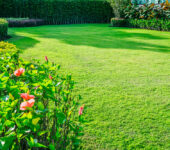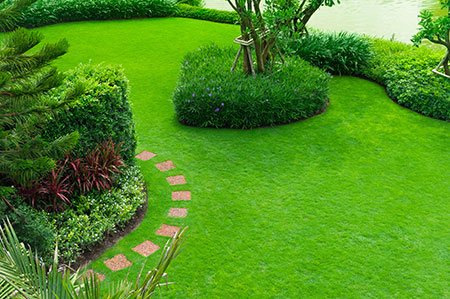
Posted On:
Category: Category:
Lawn Care Basics for your Long Island Lawn
We know it can be overwhelming. What can you do to get your lawn in shape? How low should you be mowing? How often should your lawn be watered? What are the best ways to rid your lawn of weeds? Does your lawn need fertilizer and how frequently?
We know lawn care can seem complicated. In fact, there is actual science that backs up what your lawn needs to be green and thick. But unless you have studied the basics of turf agronomy, we completely understand that it can be tough to figure out where to begin.
Whether this is your first home or a new environment, you may be craving a little refresher on the lawn care basics to give yourself the knowledge of how to do things right, feeling confident knowing each decision you make is in support of bettering your lawn and your entire home environment.
Don’t worry. We’ve got you covered. Here is a guide on some key areas so you can better maintain your lawn and become more comfortable with understanding what your lawn needs.
7 of the Best Lawn Care Tips
While this isn’t a complete textbook that outlines every scientific detail of lawn care (that would be massively complex), we have chosen the most important areas for you to focus your limited time on to ensure lawn success.
We know you don’t have the time or energy to learn an entirely new skill set, but we want you to get the best results for your lawn. Prioritizing these elements should help get you there so you can be confident and boast a great looking lawn in your Long Island neighborhood.
Tip #1: Proper Watering Is Extremely Important
You might think Mother Nature provides enough moisture for your lawn, but some years it really doesn’t. And water is essential to your lawn’s overall performance and vigor. For the optimum thickness and health, your lawn needs water.
If you see yellow grass blades or an overall loss of vigor, this could be the result of insufficient water or even drought stress.
That’s why Long Island lawn care tips include adding about 2 inches of water weekly. When the weather doesn’t deliver what your lawn needs, you need to add water with an irrigation system or supplemental watering of some kind.
In addition to inadequate water, lawns can also receive too much water. It is certainly possible to over-water a lawn, but typically Mother Nature is the one that over-delivers on the rain supply. In this case, you’ll see yellowing or spots in your lawn and assume it’s drought when, in fact, it’s a lawn disease caused by over-watering.
Your watering should be done deeper and longer and less frequently to reach your weekly water goal to encourage deeper, stronger roots and greener, healthier grass. If you water too frequently and shallowly, your lawn’s roots will just hang out near the surface. Deeper roots will always make stronger grass.
Also, ideally you want to water early in the morning before sunrise. This is because wind and sun can move your water or evaporate your water before it can soak into the soil where it’s needed.
Tip #2: Mow Right to Maximize Lawn Vitality
Another lawn care tip for beginners is proper mowing.
This is another lawn care to-do that is underestimated since you might think mowing is something you can’t mess up. Unfortunately, that’s not the case.
The mowing mistakes you can make can actually add up. You can actually mow to the wrong height, mow at the wrong frequency, and use unmaintained mowing equipment with dull mower blades.
The best Long Island lawn height is 3.5 to 4 inches. This height optimizes your lawn health, keeping it growing thick and green and keeping weeds out. Sometimes you might be tempted to cut your lawn short to look like that of your favorite golf course. Cutting your lawn too short stresses it out and could cause yellowing, browning, or let weeds in.
Weekly mowing is usually adequate during the growing season. You should only be cutting one-third of the grass blades at any one time to reach that maximum height of 3.5 to 4 inches.
Sharp mower blades and ensuring you have a level mowing deck can produce a fine and even cut. Checking your tires for proper inflation is also crucial to ensuring that consistent cut.
Tip #3: The Essentials Behind Lawn Fertilization
When developers build homes, they move soil around, taking away nutrients and organic matter in the process. This certainly doesn’t create the ideal environment for growing anything, especially grass.
That’s why your lawn needs fertilization as a part of essential lawn care basics. But one random application here or there doesn’t help.
A consistent fertilization schedule can keep building your grass up. Fertilization is as important in the spring when the growing season is kicking off as it is in the fall when the growing season is settling down. That way you’re building top growth and root growth at the time when both of those things are happening.
Tip #4: Think Beyond Fertilization
In addition to fertilization, maintaining a comprehensive lawn care program is important to your lawn’s overall health.
One such service that usually comes with fertilization in a lawn care program is pre-emergent and post-emergent weed control.
Pre-emergent herbicides target weed seeds before they germinate. This is important for weeds like crabgrass that are much easier to control before they sprout. The timing of this type of application is crucial – usually done in early spring – so a weed-like crabgrass doesn’t continue spreading its seeds.
Post-emergent products, on the other hand, tackle those weeds that have already emerged.
A lawn care basics weed killing bonus tip: This is an application that can’t just happen once a year. Unfortunately, there are multiple types of weeds that can invade your lawn at different times of year, so you want to stay ahead of them all. A comprehensive lawn care program can cover fertilization and weed control in one, giving you those multiple treatments at the right times throughout the year.
Other important services include preventative grub control if you have this infestation in your Long Island lawn.
Tip #5: Don’t Ignore Your Soil Health
The health of your soil plays a huge role in the successful growth of your lawn.
A soil that is at an inadequate pH or is lacking proper nutrients wont’ take up fertilizer or water the way it should.
That’s why the best lawn care companies provide soil tests as a part of their services. This is an absolutely essential lawn care basic that can solve a lot of problems in your lawn by giving you incredible insight into what’s happening below ground.
Lawn Care Tip #6: Aeration Has Many Advantages
You may have your lawn care basics covered. We’re talking about mowing, watering, fertilization, and weed control. But maybe your lawn still seems unwell in places.
It could need aeration. When your soil becomes compacted from years of traffic and rainfall, it can’t breathe. When it gets to this point, your lawn can’t take in water or nutrients. It’s basically starving.
Lawn aeration is the practice of using a special machine to pull out soil plugs in your lawn and redepositing them along the lawn. This creates air pockets so roots can thrive, receiving water and oxygen. Healthier roots make a thicker, healthier lawn. And you know a healthier lawn is more resistant to weeds, diseases, and even drought.
Lawn Care Tip #7: Don’t Be Afraid to Call in a Pro
Our final lawn care tip for beginners is that you should never feel ashamed to tap into a professional for your lawn care services.
Lawn care can be a lot to take on. We completely understand. Whether you’re at your first home or your third, handling your lawn care on your own can take up a lot of time you don’t have.
Call Today!
Suffolk (631) 862-5281
Nassau (516) 252-3588











